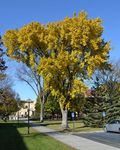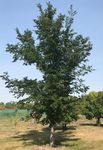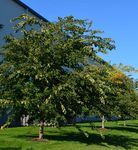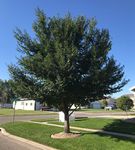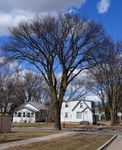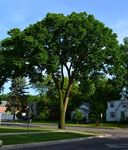Elms for North Dakota - NDSU Agriculture and Extension
←
→
Page content transcription
If your browser does not render page correctly, please read the page content below
NDSU EXTENSION EXTENDING KNOWLEDGE CHANGING LIVES F1893 Elms for North Dakota Joe Zeleznik, NDSU Extension Forester Greg Morgenson, Research Specialist, NDSU Plant Sciences Department Jim Walla, Northern Tree Specialties, Fargo Todd West, Professor, NDSU Plant Sciences Department In many North Dakota communities, American elm trees once were abundant, providing large amounts of ample shade and creating graceful archways over the streets. Dutch elm disease (DED) arrived in North Dakota in the 1970s and began to destroy this resource. Since then, much effort has been spent on identifying and testing new species or cultivars that are resistant to the disease and once again can provide those magnificent views down the roadways. While no elm species or cultivar is immune to DED, elms have varying levels of susceptibility to the disease. For more information on managing DED, refer to NDSU Extension publication PP1635, “Dutch Elm Disease in North Dakota: A New Look.” Recommended species and cultivars in this publication are generally cold hardy and have shown relatively low susceptibility to DED in research trials and/or through years of field experience. Some newer cultivars have not been tested adequately in North Dakota and they are noted below. North Dakota has two sites that are part of the National Elm Trial (http://bspm.agsci. colostate.edu/national-elm-trial/). Unless otherwise noted, the mature form of elms listed here is vase- shaped. Typical fall foliage is yellow unless listed otherwise; in some years in North Dakota, fall color may not develop on elms. The majority of elm trees need early and regular structural pruning and training to develop a single lower trunk during the first 10 to 15 years. Without regular pruning, some trees grow so fast that the main leader can fall over and break, thus making it more difficult to regain good structure that may have been developed early in their growth. Be attentive when utilizing elms. North Dakota State University, Fargo, North Dakota October 2018
American Elm (Ulmus americana)
Fully Recommended
n Prairie Expedition® (‘Lewis & Clark’) – A cold-
hardy American elm that grows up to 4 feet per
year. This cultivar has high DED resistance;
the original tree was a survivor of the first wave
of DED to come through North Dakota. NDSU
release.
n ‘Princeton’ – A fully hardy and highly
DED-resistant selection of American elm.
‘Princeton’ has a very upright form; managers
have some concern about branch angles being
too acute. However, this cultivar is easy to train
when it is young.
n ‘Valley Forge’ – This cultivar also is fully
hardy and very DED resistant, but the branch
attachments may be weaker than desired.
Also, some trees’ growth has been so vigorous
that the central leader became top-heavy
and fell over, resulting in a lopsided or
unsymmetrical crown.
Partially Recommended
The following cultivars have received relatively
little testing in North Dakota. They have high
resistance to DED and are likely hardy enough to
survive North Dakota winters. Further testing and
NDSU
experience may allow us to move these into the
Fully Recommended category.
n Colonial Spirit® (‘JFS-Prince II’)
n ‘Jefferson’
n ‘New Harmony’
n ‘St. Croix’ – Originated in southeastern
Minnesota
Not Recommended
The following cultivars are not recommended for
North Dakota due to their poor resistance to DED
and/or lack of cold hardiness.
n ‘American Liberty’
n ‘Brandon’
n ‘Independence’
n ‘Minneapolis Park’
n Washington
n American elm – seedling origin
Greg Morgenson, NDSU
2Hybrid Elms Partially Recommended
A large number of hybrids have been developed utilizing Asian and n ‘Patriot’ – While this tree has proven to
European elm species as parents. Hardiness, growth characteristics and be cold hardy, it has been midrange in
pest resistance are highly variable. While our list is not exhaustive, these other characteristics, and sometimes can
cultivars are most likely to be seen in the nursery industry in this region. have a large amount of damage from
foliage-feeding insects.
n ‘Pioneer’ – A medium to large tree with
Fully Recommended a dense, rounded crown. Generally
n Accolade™ (‘Morton’) – A large, hardy tree that will do well in North considered hardy to Zone 5, ‘Pioneer’
Dakota. In one trial, it scored midrange in terms of survival, growth and has shown mixed
natural structure; it may have codominant stems that will need pruning results in North Dakota trials, with
when young. Leaves are dark like American elm but smaller. Overall survival ranging from
tree form similar to American elm. 0 to 100 percent at three sites.
n ‘Cathedral’ – A very fast-growing tree that requires annual pruning for n Vanguard™ (’Morton Plainsman’) –
the first 10 years to develop good structure. The long branches give Definitely a hardy cultivar but has proved
young trees a somewhat weeping form. Only moderately resistant to to be midrange in growth, pest-resistance
DED. and ornamental characteristics. Upright
n Commendation™ (‘Morton Stalwart’) – A somewhat upright tree, but form.
the overall form is more oval than vase-shaped. Leaves are relatively
large and fall color is a muted yellow. A good tree, but scored midrange Not Recommended
in North Dakota trials. Likely lower maintenance than Accolade™ or The following cultivars are not
‘Cathedral’ elm. recommended because of hardiness
n Danada Charm™ (‘Morton Red Tip’) – Somewhat upright tree with fast problems, wildlife issues and/or high
growth. Has performed extremely well in trials in Bismarck and Fargo. amounts of damage from foliage-feeding
Emerging new growth has a reddish tinge. insects.
n ‘New Horizon’ – A medium tree with slightly arching branches, upright n ‘Frontier’
oval form and dark green leaves. Fall color is yellowish brown and
develops later than other cultivars. One of the better elm trees in NDSU n ‘Homestead’
trials, tolerating very dry conditions in one central North Dakota site. n ‘Lincoln’
May suffer some damage from foliage-feeding insects. n ‘Prospector’
n Triumph™ (‘Morton Glossy’) – Outstanding tree for much of North n ‘Regal’
Dakota. Shiny, attractive dark green foliage. Somewhat upright form.
‘Patriot’
‘Cathedral’ ‘New Horizon’
Greg Morgenson, NDSU
3Japanese Elm ‘Freedom’
(Ulmus davidiana var. japonica)
In Asia, Japanese elm has a very large native range.
Northern seed sources generally have done well in
North Dakota. However, if you do not know the seed
source of the tree, or if it is not one of the recommended
cultivars listed below, be cautious.
Fully Recommended
n ‘Discovery’ – A very slow-growing tree with a very
dense crown and many fine branches. Highly
resistant to DED.
n ‘Freedom’ – This cultivar was selected in Manitoba
and is very cold hardy. Mature trees achieve a Northern Empress® ‘Discovery’
compact mushroom-shaped form. Fall foliage gets a
red/purple tinge. May be difficult to find in the nursery
industry.
n Northern Empress® (‘Burgundy Glow’) – A small
to medium-sized tree with a rounded crown, open
branching and attractive foliage. Fall foliage changes
from green to apricot-orange to burgundy red before
leaf drop. First availability in retail nurseries in 2021.
NDSU release.
‘Discovery’
Partially Recommended
n Greenstone™ (‘JFS KW2UD’) – A new release
that has not been tested in North Dakota. However,
Greenstone™ was selected from a northern seed
source. Has the upright, vase-shaped form of the
American elm, although a shorter mature height.
n ‘Night Rider’ – A new release that has not been
tested in North Dakota, although it is being sold in
Manitoba, Canada. Purple fall color.
Not Recommended
Greg Morgenson, NDSU
n Emerald Sunshine® (‘JFS-Bieberich’) – Lacking
sufficient cold hardiness for North Dakota. NDSU Extension does not endorse commercial products or
companies even though reference may be made to tradenames,
trademarks or service names.
Siberian Elm (Ulmus pumila) NDSU encourages you to use and share this content, but please
Siberian elm has been used mostly in shelterbelts, do so under the conditions of our Creative Commons license. You
may copy, distribute, transmit and adapt this work as long as you
especially since the 1950s, and often is found in North
give full attribution, don’t use the work for commercial purposes
Dakota communities. It is cold hardy and highly drought and share your resulting work similarly. For more information, visit
tolerant but has a lifespan of only 40 to 60 years. While www.ag.ndsu.edu/agcomm/creative-commons.
relatively resistant to DED, this species is sensitive to
damage from broadleaf herbicides and is susceptible to
black-spot Nectria canker (formerly Tubercularia canker).
For more information on this and other
topics, see www.ag.ndsu.edu
Note: Siberian elm (Ulmus pumila) sometimes is County commissions, North Dakota State University and U.S. Department of
referred to as Chinese elm. However, another species Agriculture cooperating. NDSU does not discriminate in its programs and activities on
the basis of age, color, gender expression/identity, genetic information, marital status,
known as lacebark elm (Ulmus parvifolia) also national origin, participation in lawful off-campus activity, physical or mental disability,
sometimes is called Chinese elm. To be clear, Siberian pregnancy, public assistance status, race, religion, sex, sexual orientation, spousal
elm (Ulmus pumila) is hardy in North Dakota; lacebark relationship to current employee, or veteran status, as applicable. Direct inquiries
to Vice Provost for Title IX/ADA Coordinator, Old Main 201, NDSU Main Campus,
elm (Ulmus parvifolia) should not be considered to be 701-231-7708, ndsu.eoaa@ndsu.edu. This publication will be made available in
adapted to North Dakota conditions. alternative formats for people with disabilities upon request, 701-231-7881.You can also read




